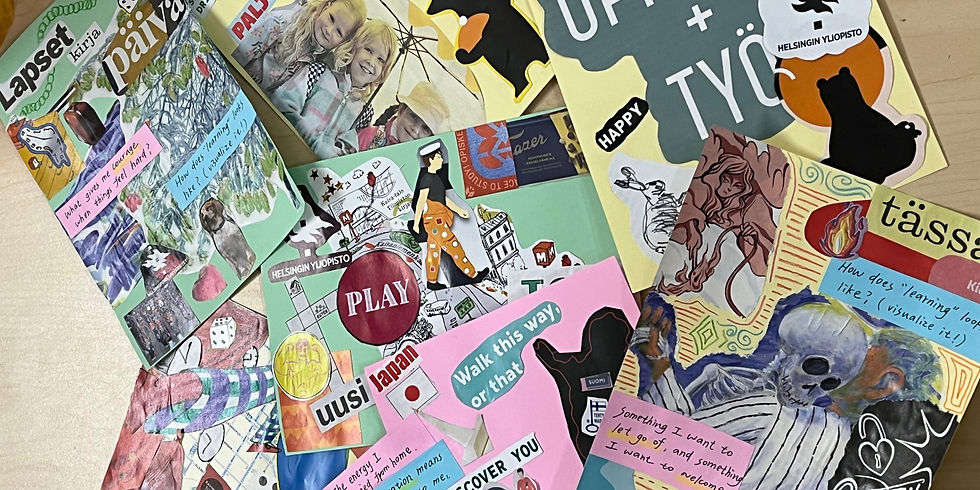Neuroscience Research: From Academia to Practice
- Mihaela Nyyssönen

- Apr 25, 2021
- 5 min read
Updated: Apr 27, 2021
An insight into the process of creating research-based practices in early childhood education.
Very often adjacent to the concept of Finnish education comes the term research-based. This seems to be an inbuilt answer to the eternal question of why Finnish education is so successful. Trying to decode the term, we often come across two perspectives: one is about designing pedagogical practices and creating content based on research findings and the second is about using research as a tool to improve education provision. Surely, this is a simplistic explanation and research-based education can be analyzed extensively at different levels. Therefore, this article offers only a small insight into the connection between academia and practice by focusing on how neuroscience research findings can be used to enhance children’s learning and adjust practices in early child childhood education. The examples offered in this article are focused on three topics: supporting curiosity, using physical activities to enhance learning, and the importance of music activities for the children’s social behavior.
Let the children ask the questions!

Curiosity is the driver of learning and young children show that by asking a hundred questions a minute to the desperation of their parents and teachers. But how exactly is curiosity facilitating learning and, more importantly, how it can be used by teachers to make the most of the teaching experience? The answer to these questions can start from a study done by Min Jeong Kang and others, where curiosity was analyzed in correlation to memory. The findings revealed that high levels of curiosity are connected to better memory recall. Another important addition to these findings is the fact that curiosity generation is conditioned by the previously acquired information of the child or by the presence of a stimulus, such as an interesting new activity or a book. This information is especially important for teachers who can assist children to foster their curiosity by facilitating interesting learning opportunities. These learning opportunities need to be connected to topics the children are slightly familiar with and then an efficient learning experience may occur.
Some simple ways to assess what the children already know are by observing the children, engaging in play with them, and listening to them. Then the next step would be to plan activities based on their interests. As a practical example, let’s imagine that some children have been playing dinosaurs for the past couple of weeks. They run about and roar. This can be a cue that they know something about dinosaurs. This observation can be used to plan a series of activities on this topic: counting dinosaurs, painting, learning a new game, reading some interesting books, etc. This holistic type of learning around a topic that came from the children enables a teacher to use the children’s curiosity related to dinosaurs to teach them a wide range of skills. Hence, the conclusion is to encourage children to ask a hundred questions as they lead to an increase in their curiosity levels and consequently to learning.
Shall we play tag?

The effects of physical activity in enhancing learning have been studied by neuroscientists for a long time. Some of the studies reveal that physical activity not only helps children to concentrate better but the time interval when this type of activity occurs influences learning in different ways. For instance, in an experiment done by Hoza and others, 30 minutes of physical activity before school started was organized for children with ages ranging from 5 to 9. Some of the children had ADHD symptoms, undiagnosed, and others did not. In the experiment, a total of 202 children were divided into two groups. Half of them played active games before school started and the others engaged in classroom activities that required sitting. The results showed a greater decrease in ADHD symptoms for children who are at risk of ADHD and an improvement for the other children as well in the physical activity group compared to the sedentary activity group. Another study done on rats in 2010 by Berchtold, Castello, and Cotman discovered that the timing of physical activity is also important. The experiment was about rats learning to perform in a maze. The results revealed that the rats' best performance in the maze was one week after physical activity, but the best learning and memory recall was the best right after the exercise. These two main studies are significant in terms of understanding how teachers can use physical activities strategically to enhance children’s learning. For example, creating daily routines so that outdoor play is scheduled before focused activities and planning short physical activities to help children concentrate at the beginning of a circle time or other session is a couple of efficient ways of applying research findings to practice.
Bring on the music!

Music activities are an integral part of early childhood education. Depending on each daycare setting and teacher, these may take place weekly or even several times a day. They can take the form of singing songs, playing untuned instruments, or matching music with movement. Neuroscience research has been generously revealing many of the benefits of music throughout the years. For instance, a study done in 2013 by Putkinen, Saarikivi, and Tervaniemi disclosed that children’s attention can be increased by frequent exposure to informal music activities. These findings point out that children who listen and play to music daily have higher language and attention skills than children who have less music in their everyday life. In addition, rhythmical musical games played together with peers help children to synchronize and support social interactions. Also, rhythmical musical games played together with peers help children to synchronize and support social interactions. Playing some soothing music during arts and crafts sessions, singing spontaneously during outdoor play, or dancing with the children are some of the multiple activities that can be done every day in the daycare setting. They will enhance children’s auditory skills, promoting the development of language, attention, and social skills.
Another study that emphasizes the importance of music in early childhood education is about increasing collaboration among peers by making music together. In the study, 4-year-old children worked in pairs and an adult to play percussion instruments while singing and dancing to an easy tune new song. After that, they were asked to do a collaboration task together. As a result, children showed cooperation and support for each other that carried on after the music session has ended. This type of activity can be used to build and consolidate relationships between peers, especially during the settling-in time. Teachers can support the children’s prosocial skills through short joint musical activities. This way, everyone in the classroom can enjoy the outcomes of music, being children or adults.
As can be seen, making research-based pedagogical choices when facilitating learning in early childhood education is something any teacher can do. The way to implement this type of process is by keeping up to date with the latest research findings and applying them in practice.
References
Berchtold, N., Castello, N., & Cotman, C. (2010). Exercise and time-dependent benefits to learning and memory. Neuroscience, 167(3), 588–597. https://doi.org/10.1016/j.neuroscience.2010.02.050
Hoza, B., Hoza, B., Smith, A., Smith, A., Shoulberg, E., Shoulberg, E., Linnea, K., Linnea, K., Dorsch, T., Dorsch, T., Blazo, J., Blazo, J., Alerding, C., Alerding, C., McCabe, G., & McCabe, G. (2015). A Randomized Trial Examining the Effects of Aerobic Physical Activity on Attention-Deficit/Hyperactivity Disorder Symptoms in Young Children. Journal of Abnormal Child Psychology, 43(4), 655–667. https://doi.org/10.1007/s10802-014-9929-y
Kirschner, S., & Tomasello, M. (2010). Joint music making promotes prosocial behavior in 4-year-old children. Evolution and Human Behavior, 31(5), 354–364. https://doi.org/10.1016/j.evolhumbehav.2010.04.004
Min Jeong Kang, Ming Hsu, Ian M. Krajbich, George Loewenstein, Samuel M. McClure, Joseph Tao-yi Wang, & Colin F. Camerer. (2009). The Wick in the Candle of Learning: Epistemic Curiosity Activates Reward Circuitry and Enhances Memory. Psychological Science, 20(8), 963–973. https://doi.org/10.1111/j.1467-9280.2009.02402.x
Putkinen, V., Saarikivi, K., and Tervaniemi, M. (2013). Do informal musical activities shape auditory skill development in preschool-age children? Front. Psychol. 4:572. https://doi.org/10.3389/fpsyg.2013.00572
About Mihaela

With an academic background in early childhood education and social services, Mihaela Nyyssönen is currently a student in the Changing Education Master's programme. She believes everyone has the potential to become an educational game-changer when they are in the right environment.




Comments